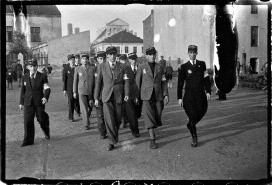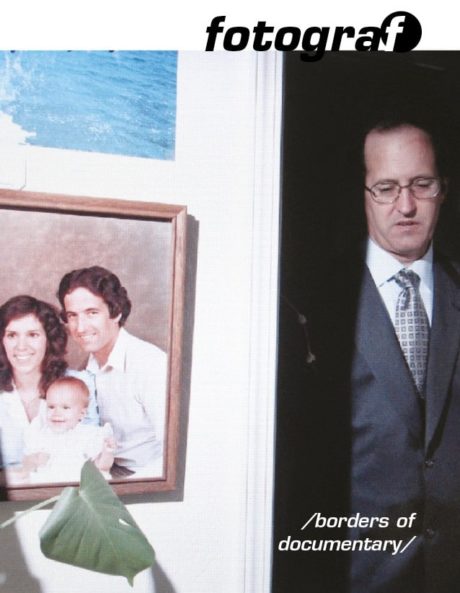Henryk Ross: Lódź ghetto album
A slightly controversial exhibit of photographs by Henryk Ross in Prague’s Langhans gallery presents works whose importance lies both in their visual impact and artistic quality but above all in their content, becoming an important historic testimony which brings new and often surprising images of the holocaust and life in the Nazi ghettoes during World War II. The intriguing story of the circumstances under which the photographs were taken and ”survived“ to be eventually exhibited is no less compelling than the pictures themselves.
The black-and-white photos depict life in Poland’s Łódź ghetto, where Henryk Ross, a Polish photographer of Jewish descent born in 1910 in Warsaw, was sent along with tens of thousands of other Jews, among them also Czechs. His life in the ghetto was a little unusual, however; looking at the exhibited photographs, which are full of contradictions, one might get the impression that he lived a double life in the ghetto. Officially, as an employee of the Judenrat (the Jewish council which ran the ghetto under Nazi supervision and which was headed by infamous the Chaim Rumkowski) he was in charge of taking photographs of the ghetto inhabitants, documenting products made in the ghetto and producing propaganda photos required by the Germans. On the side, in fact secretly, he took photos of the ”real“ life in the ghetto.
In 1987, four years before his death, Ross described: ”As I officially owned a camera, I could photograph the life of Jews in the ghetto. Shortly before the ghetto’s liquidation in 1944, I buried the negatives so that there would be a record of our tragedy, especially about the total extermination of the Łódź Jews by the Nazi executioners. I wanted to leave behind a historical document about our suffering.“ After the war Ross, one of the few survivors, returned to the same place and unearthed the 6000 negatives. For a long time, however, he was reluctant to make them public. Considering the dramatic circumstances under which they were taken and preserved this may seem paradoxical, but the reasons become quite obvious when we look at some of the pictures.It was not until 1961 that some of Ross’ photographs were made available to the public – not within the context of photographic art but as evidence during the trial of one of the leading personalities of the holocaust, Adolf Eichmann, which took place in Israel, where Henryk Ross settled after the war and worked as a photographer. The entire collection of his photographs, which is now owned by London’s Archive of Modern Conflict, was not presented until 2004 in Arles; their second exhibit was at Prague’s Langhans gallery, where 50 of the approximately 3000 preserved photographs could be seen.
Those fifty enlargements represent a sophisticated selection from Ross’s work, as they betray the ambiguity of his photographs. One part of the photographs corresponds with the dreadful and barely believable, but generally known, face of the holocaust. Even though we can never be totally prepared to take in the images and scenes captured in the photographs, we are familiar with them from documentaries or historical books and somehow expect such images in relation to the subject. They show the suffering of victims: deportations, starving children, executions and other atrocities that were happening in Nazi ghettoes and concentration camps.
Nevertheless, one factor that makes the whole exhibit so particularly compelling and ambivalent is the fact that we encounter pictures which produce a totally opposite impression, making them even more shocking than the dreadful images of the tragedy of life in the ghetto. This second part includes scenes that most visitors find utterly surprising and that are unknown in this context: nicely dressed children, plates laden with food, smiling people, a wedding reception, hugging couples, in short, everyday, intimate scenes from mundane life with all its joy – images that radiate peace and happiness. Most visitors, not unlike the Łódź ghetto survivors themselves as it later turned out, would probably assume that these photographs were taken before the war. The opposite is the truth; these images of the ghetto do not capture the regular life of most of its residents but that of a privileged minority, the group of Jewish inhabitants in charge of running and supervising the ghetto, who were able to live a relatively normal life when compared with the masses, and perhaps were able to ensure slightly better chances at survival.
Some visitors will probably have no difficulty coping with these images and will take them as another piece of evidence and useful visual testimony about historical reality. Many others, however, might find it hard to incorporate them into their idea of the holocaust, to put them in an appropriate context. The photos will doubtless give rise to various judgments which the photographer himself obviously tried to prevent by never publicising these particular photographs during his life. Since the people being photographed do not seem surprised or disturbed by the photographer’s presence, it is clear that Ross belonged to the ”elite“ caste and as such can be accused of a certain form of collaboration. There are several arguments countering such accusations. The most important is the fact that, by taking some of the photographs, Henryk Ross was risking his own life and that of his family; what is more, he was reluctant to publicise his visual testimony because it seems to contradict the horrifying image of holocaust.
More strongly than anywhere else, we are here confronted with the deceptive nature of photography – we automatically take the reproduced scenes at face value, while they only capture a fraction of reality, a single still moment which is always to a degree distorted. As long as we are aware of this, the contradictions between the two types of photographs may not seem so extreme as they may at first sight. While some of the images, taken with an artistic skill that enhances their atmosphere, show smiling and relaxed ghetto inhabitants, it is good to bear in mind that like all the others they, too, were imprisoned and most of them (including Rumkowski himself) were eventually, perhaps not long after the pictures were taken, deported to one of the death camps to die.
In spite of all the doubts and difficulties ensuing from the historical context, the photographs boast artistic qualities, carefully composed and often superb angles (given the circumstances, of course), which Henryk Ross, as a professional photographer, knew how to work with. Not even the defects caused by the period when the negatives were buried in a wooden box and many became water-damaged diminish their artistic quality. Stains and ”imperfections“ caused by the unfavourable conditions give the prints a certain hallmark of authenticity, and the fact that no additional touch-ups were done to the photographs and that they are reproduced in their original state only enhances their artistic quality and lets them speak for themselves. We can thus appreciate them, in the same way as other works of art, for their credible rendition of experiences that, for most of us, are barely imaginable.
#5 Borders of Documentary
Archive
- #45 hypertension
- #44 empathy
- #43 collecting
- #42 food
- #41 postdigital photography
- #40 earthlings
- #39 delight, pain
- #38 death, when you think about it
- #37 uneven ground
- #36 new utopias
- #35 living with humans
- #34 archaeology of euphoria
- #33 investigation
- #32 Non-work
- #31 Body
- #30 Eye In The Sky
- #29 Contemplation
- #28 Cultura / Natura
- #27 Cars
- #26 Documentary Strategies
- #25 Popular Music
- #24 Seeing Is Believing
- #23 Artificial Worlds
- #22 Image and Text
- #21 On Photography
- #20 Public Art
- #19 Film
- #18 80'
- #17 Amateur Photography
- #16 Photography and Painting
- #15 Prague
- #14 Commerce
- #13 Family
- #12 Reconstruction
- #11 Performance
- #10 Eroticon
- #9 Architecture
- #8 Landscape
- #7 New Staged Photography
- #6 The Recycle Image
- #5 Borders Of Documentary
- #4 Intimacy
- #3 Transforming Of Symbol
- #2 Collective Authorship
- #1 Face

